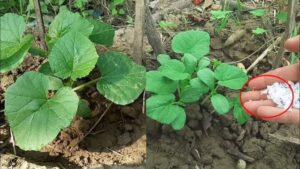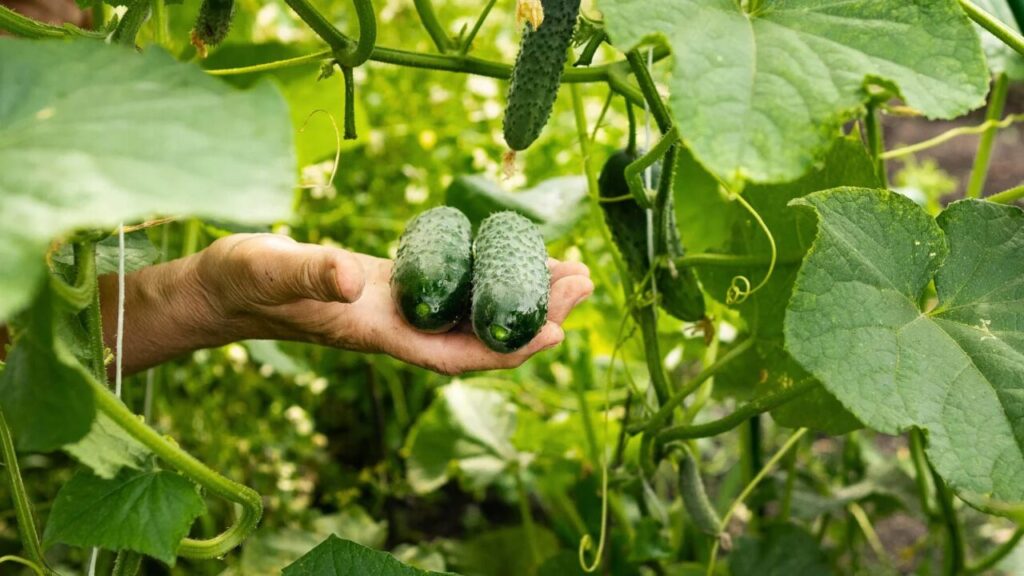Last updated on July 5, 2025
To achieve optimal yields and healthy cucumber plants, a precise understanding of NPK fertilization is crucial. The ideal NPK ratio is not a universal constant; it varies based on application timing, location-specific soil conditions, and the plant’s growth stage. This guide provides detailed, expert-backed information to help you make informed fertilization decisions.
Why Fertility Management Matters for Cucumbers
Cucumbers are rapid growers with quick fruit development, demanding a consistent nutrient supply. Inadequate or imbalanced nutrition can manifest as stunted growth, yellowing leaves, poor fruit set, or bitter, misshapen cucumbers. Research, including studies from NC State University and the University of Florida, emphasizes that precise nutrient management throughout the crop cycle is key to maximizing both yield and fruit quality. For instance, the Cucumber Production Guide from Oklahoma State University highlights the importance of appropriate fertilization for cucumber growth and yield.
Interpreting Soil Tests: The Foundation of Proper Fertilization
Soil tests are an essential first step. Here’s what to look for:
- Soil pH: Cucumbers thrive in a pH range of 6.0 to 6.8. A pH outside this range can hinder nutrient availability. Use lime to increase pH or sulfur to lower it as needed before planting, consulting your local Cooperative Extension Office for specific recommendations.
- Macronutrients (N-P-K):
- Phosphorus (P): Aim for medium to high levels, around 60-100 lbs/acre.
- Potassium (K): Cucumbers are potassium-demanding; maintain levels between 120-200 lbs/acre.
- Nitrogen (N): Soil tests don’t typically include nitrogen, so application is based on the crop stage, as detailed below.
- Micronutrients: Ensure adequate levels of boron, manganese, zinc, and iron, as deficiencies can significantly impact cucumber growth. A helpful resource on micronutrient management can be found in this Cornell University article.
- If soil tests reveal deficiencies:
- Apply a pre-plant fertilizer (e.g., 10-20-20) for low P or K.
- Use foliar sprays or soil-applied chelates for micronutrient deficiencies.
- If soil tests reveal deficiencies:
NPK Fertilizer Schedule for Cucumbers
A well-structured fertilization schedule is crucial. Here’s a general guideline based on trials from the University of Georgia:
- Pre-Plant: Apply 30-40% of total nitrogen, along with all required phosphorus and potassium. A balanced granular fertilizer like 10-10-10 or 10-20-20, at rates of 50-70 lbs/acre of N, 60-100 lbs/acre of P2O5, and 80-120 lbs/acre of K2O, is generally suitable.
- Vining Stage: Apply an additional 30-40 lbs/acre of N, around 3-4 weeks post-planting. Liquid nitrogen, such as urea ammonium nitrate (UAN) via drip irrigation, is effective at this stage.
- Fruit Set & Harvest: Apply 10-15 lbs/acre of N every 7-10 days through drip fertigation. Pay close attention to potassium levels, as it is crucial for fruit size and quality. In sandy soils, more frequent, smaller applications are necessary to prevent leaching.
The University of Florida Institute of Food and Agricultural Sciences (UF/IFAS) emphasizes the efficiency of drip fertigation in cucumber production, as detailed in their research on Nitrogen, Phosphorus, and Potassium Research with Cucumber in Florida.
Timing Matters: When Should You Apply NPK?
The timing of NPK application is critical for maximizing cucumber yield:
- Before Planting: Apply a balanced NPK fertilizer, emphasizing phosphorus.
- Early Vegetative Stage: Use a formulation such as 5-10-10 to promote root development without stimulating excessive leaf growth.
- Mid-Season (Flowering and Fruiting): Increase potassium levels by using a 10-20-30 or similar low-nitrogen, high-potassium blend to support fruit set and enhance fruit quality.
- Side Dressing: Apply additional nitrogen (40-60 lbs/acre) when vines begin to run, particularly if lower leaves exhibit yellowing.
Pro Insight: Research from the Canadian Journal of Plant Science demonstrates that dividing fertilizer applications into multiple, smaller applications significantly increases cucumber yields compared to a single, large application.
Liquid vs. Granular NPK for Cucumbers—Which Is Better?
The choice between liquid and granular fertilizers depends on specific growing conditions and management practices:
- Granular fertilizers: Such as 5-10-10 or 8-24-24 blends, are well-suited for pre-plant application and provide a sustained, gradual release of nutrients. They are also typically more cost-effective.
- Liquid fertilizers/fertigation: Offer greater control over nutrient delivery during the growing season, particularly in greenhouse or drip-irrigated systems. As the University of Florida Institute of Food and Agricultural Sciences (UF/IFAS) notes, drip fertigation is about 25-30% more efficient than broadcasting, as detailed in their research on Nitrogen, Phosphorus, and Potassium Research with Cucumber in Florida.
Fertigation requires careful attention to nutrient ratios beyond NPK. Haifa Group research emphasizes the importance of the potassium-to-calcium (K/Ca) ratio, identifying 1.33 as optimal in nutrient solutions for cucumbers. Therefore, fertigation necessitates a balanced approach to calcium, magnesium, and micronutrient management in addition to NPK.
Don’t Forget Micronutrients!
Micronutrient deficiencies, particularly in sandy soils or high pH conditions, can limit cucumber yields. Key micronutrients and their roles include:
- Boron (B): Essential for flower development and fruit set (0.5-1.0 ppm). Deficiency can cause hollow fruit and blossom-end rot.
- Manganese (Mn): Important for photosynthesis and root growth (20-60 ppm). Deficiency leads to yellowing between leaf veins.
- Calcium (Ca): Crucial for cell wall development and fruit firmness. Deficiency can cause tip burn and misshapen fruit.
| Micronutrient | Ideal Range (ppm) | Role in Cucumbers | Signs of Deficiency |
| Boron | 0.5–1.0 | Flower development, fruit set | Hollow fruit, blossom-end rot |
| Manganese | 20–60 | Photosynthesis, root growth | Yellowing between veins |
| Calcium | Not always on soil test | Cell walls, fruit firmness | Tip burn, misshapen fruit |
How to apply them:
- Use foliar micronutrient mixes early in the season.
- If you’re organic, go with seaweed extracts or borax (in very small amounts).
- For calcium, gypsum or calcium nitrate are your best bets.
Foliar micronutrient mixes are effective early in the season. Organic growers can use seaweed extracts or small amounts of borax. Gypsum or calcium nitrate are good calcium sources. For more detailed information on micronutrient management, Cornell University provides a valuable resource in this Cornell University article.
Organic Fertilizer Options for Cucumber Production
For growers who prefer organic methods, several options can provide the necessary nutrients for cucumbers:
- Compost: Well-decomposed compost improves soil structure, water retention, and provides a slow-release source of nutrients.
- Manure: Aged or composted manure (e.g., cow, poultry) is rich in nutrients. Apply 2-3 weeks before transplanting.
- Bone meal: A good source of phosphorus, particularly useful for promoting root growth and flowering.
- Kelp meal/Seaweed extract: Provides potassium and trace minerals, enhancing overall plant health and fruit quality.
- Wood ash: Adds potassium but also raises soil pH, so use sparingly.
For those interested in the best organic fertilizers, this article on best organic fertilizers with NPK values provides additional insights.
Regional Considerations: Does Country or Climate Matter?
Regional and climatic factors significantly influence cucumber fertilization practices:
- USA & Canada: Potassium supplementation is often necessary, especially in sandy soils or areas with high rainfall, which can leach potassium.
- Australia: Monitor for salt accumulation when using fertigation, as Australian soils are prone to salinity.
- Nigeria: Heavy tropical rainfall can lead to nutrient leaching. Split applications and the incorporation of organic matter are essential. A high-phosphorus, high-potassium fertilizer should be used early, followed by nitrogen side-dressing as the crop develops. Information on cucumber farming practices in Nigeria, including fertilization, can be found in these articles:
- UK: Greenhouse-grown cucumbers often require supplemental calcium and magnesium in addition to standard NPK fertilization.
Bonus Tip: For container or hydroponic cucumber production, utilize a complete, water-soluble fertilizer with a 20-10-20 or 3-1-2 NPK ratio, and ensure it contains essential micronutrients like boron and manganese. Apply at half-strength every 7-10 days, as containers dry out and deplete nutrients faster. Epsom salt (1 tablespoon per gallon as a foliar spray) can provide magnesium and sulfur if needed.
Pro Takeaways: What Should You Actually Do?
Let’s keep it actionable. Here’s how to fine-tune your cucumber fertilization plan:
- ✅ Test before you apply—soil analysis should guide your ratios.
- ✅ Start with balanced P and K at planting, then increase nitrogen gradually.
- ✅ Split applications reduce losses and boost efficiency.
- ✅ Watch your plants. Yellowing lower leaves? You might need more nitrogen. Poor fruit set? Check potassium.
- ✅ Adjust by season. Rains, heat, and crop cycles all affect nutrient needs.
Cucumber Fertilization Hub
Your comprehensive guide and calculator for maximizing cucumber yields with expert fertilization tips.
NPK Recommendation by Growth Stage
Select the growth stage to get recommended NPK ratios and application rates for your cucumbers.
Soil Testing Basics
Learn why and how to test your soil for optimal cucumber health.
Custom Soil Test Input
Enter your soil test results to calculate nutrient needs. You can also customize target ranges.
Saved Soil Tests
View your historical soil test results.
Fertilizer Application Calculator
Calculate how much fertilizer you need based on NPK ratio and land area.
Regional Considerations
Get tailored fertilization advice based on your region.
Micronutrient Deficiency Checker
Identify potential micronutrient deficiencies based on plant symptoms.
Soil pH Management Guide
Understand and adjust your soil pH for optimal cucumber growth.
Organic Fertilizer Guide
Explore organic options for nourishing your cucumber plants.
Container/Hydroponic Tips
Specific fertilization advice for container and hydroponic systems.
General Fertilization Best Practices
Key takeaways for maximizing cucumber yields.
FAQ: Cucumber Fertilization
Q: Can I use 10-10-10 fertilizer all season long?
A: Not recommended. Cucumbers need more potassium during fruiting, so shift to higher K formulas mid-season.
Q: My cucumber leaves are turning yellow. What should I check first?
A: Start with nitrogen and water levels. If both are adequate, check for micronutrient deficiencies, especially manganese or magnesium.
Q: Can I grow cucumbers with just organic compost or manure?
A: You can, but they’ll likely need more potassium. Supplement with kelp meal, wood ash (in moderation), or a certified organic liquid feed.
Q: Is Epsom salt good for cucumbers?
A: It can be! Epsom salt provides magnesium and sulfur. Use 1 tablespoon per gallon as a foliar spray if needed.
Q: Can I grow cucumbers with just organic compost or manure?
A: You can, but they’ll likely need more potassium. Supplement with kelp meal, wood ash (in moderation), or a certified organic liquid feed.
Conclusion
Optimal cucumber fertilization requires careful attention to soil testing, nutrient balance, application timing, and regional considerations. By understanding the dynamic NPK needs of cucumbers and other essential nutrients, growers can achieve healthy plants, abundant yields, and high-quality fruit.
Have you tried different NPK ratios for your cucumbers? Got a tip or something that worked (or failed)?
I’d love to hear about it in the comments—let’s help each other grow better food


